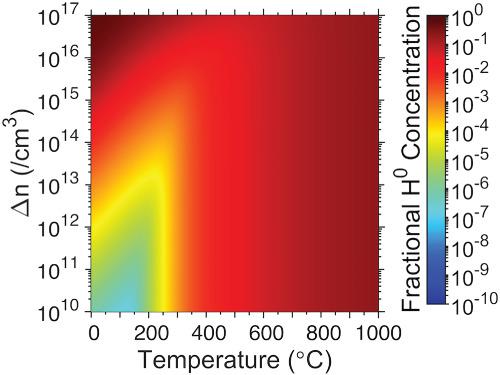当前位置:
X-MOL 学术
›
Prog. Photovoltaics
›
论文详情
Our official English website, www.x-mol.net, welcomes your feedback! (Note: you will need to create a separate account there.)
Development of advanced hydrogenation processes for silicon solar cells via an improved understanding of the behaviour of hydrogen in silicon
Progress in Photovoltaics ( IF 6.7 ) Pub Date : 2020-01-10 , DOI: 10.1002/pip.3240 Brett J. Hallam 1 , Phill G. Hamer 1 , Alison M. Ciesla née Wenham 1 , Catherine E. Chan 1 , Bruno Vicari Stefani 1 , Stuart Wenham 1
Progress in Photovoltaics ( IF 6.7 ) Pub Date : 2020-01-10 , DOI: 10.1002/pip.3240 Brett J. Hallam 1 , Phill G. Hamer 1 , Alison M. Ciesla née Wenham 1 , Catherine E. Chan 1 , Bruno Vicari Stefani 1 , Stuart Wenham 1
Affiliation

|
The understanding and development of advanced hydrogenation processes for silicon solar cells are presented. Hydrogen passivation is incorporated into virtually all silicon solar cells, yet the properties of hydrogen in silicon are still poorly understood. This is largely due to the complex behaviour of hydrogen in silicon and its ability to exist in many different forms in the lattice. For commercial solar cells, hydrogen is introduced into the device through the deposition of hydrogen‐containing dielectric layers and the subsequent metallisation firing process. This process can readily passivate structural defects such as grain boundaries but is ineffective at passivating numerous defects in silicon solar cells such as the boron‐oxygen complex, responsible for light‐induced degradation in p‐type Czochralski silicon. This difficulty is due to the need to first form the boron‐oxygen defect and also due to atomic hydrogen naturally occupying low‐mobility and low‐reactivity charge states. However, these challenges can be overcome using advanced hydrogenation processes incorporating excess carrier generation from illumination or current injection that increase the concentration of the highly mobile and reactive neutral charge state. As a result, after fast firing, additional low‐temperature advanced hydrogenation processes incorporating illumination can be implemented to enable the passivation of difficult defects like the boron‐oxygen complex. With the implementation of such processes for industrial silicon solar cells, efficiency improvements of 1.1% absolute can be obtained.
中文翻译:

通过增进对硅中氢行为的了解,开发用于硅太阳能电池的高级氢化工艺
介绍了硅太阳能电池高级氢化工艺的理解和发展。几乎所有硅太阳能电池都采用了氢钝化技术,但硅中氢的性质仍然知之甚少。这主要是由于氢在硅中的复杂行为及其以晶格中许多不同形式存在的能力。对于商用太阳能电池,通过含氢介电层的沉积以及随后的金属化焙烧过程将氢引入器件。这个过程可以很容易地钝化诸如晶界之类的结构缺陷,但是不能钝化硅太阳能电池中的许多缺陷,例如硼氧配合物,这会导致光致p型切克劳斯基硅的降解。该困难是由于需要首先形成硼氧缺陷,也由于原子氢自然占据了低迁移率和低反应性电荷态。但是,使用先进的加氢工艺可以克服这些挑战,因为加氢工艺结合了照明或电流注入产生的过量载流子,从而增加了高迁移率和反应性中性电荷态的浓度。因此,在快速烧制后,可以实施附加照明的低温低温加氢工艺,以钝化诸如硼氧配合物之类的困难缺陷。通过将这种方法用于工业硅太阳能电池,可以实现1.1%绝对绝对效率的提高。
更新日期:2020-01-10
中文翻译:

通过增进对硅中氢行为的了解,开发用于硅太阳能电池的高级氢化工艺
介绍了硅太阳能电池高级氢化工艺的理解和发展。几乎所有硅太阳能电池都采用了氢钝化技术,但硅中氢的性质仍然知之甚少。这主要是由于氢在硅中的复杂行为及其以晶格中许多不同形式存在的能力。对于商用太阳能电池,通过含氢介电层的沉积以及随后的金属化焙烧过程将氢引入器件。这个过程可以很容易地钝化诸如晶界之类的结构缺陷,但是不能钝化硅太阳能电池中的许多缺陷,例如硼氧配合物,这会导致光致p型切克劳斯基硅的降解。该困难是由于需要首先形成硼氧缺陷,也由于原子氢自然占据了低迁移率和低反应性电荷态。但是,使用先进的加氢工艺可以克服这些挑战,因为加氢工艺结合了照明或电流注入产生的过量载流子,从而增加了高迁移率和反应性中性电荷态的浓度。因此,在快速烧制后,可以实施附加照明的低温低温加氢工艺,以钝化诸如硼氧配合物之类的困难缺陷。通过将这种方法用于工业硅太阳能电池,可以实现1.1%绝对绝对效率的提高。



























 京公网安备 11010802027423号
京公网安备 11010802027423号